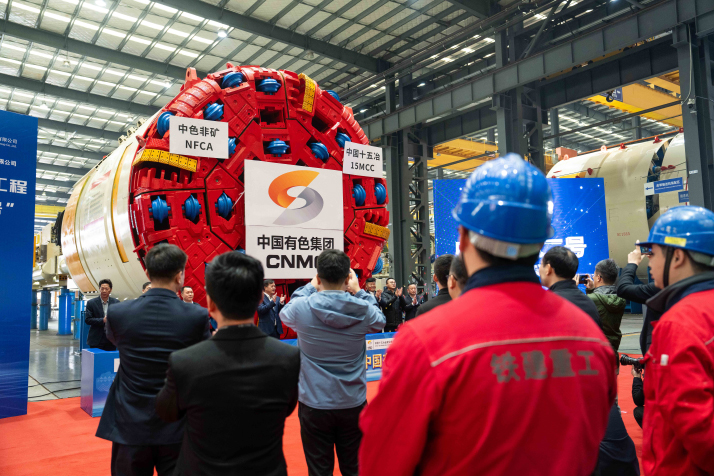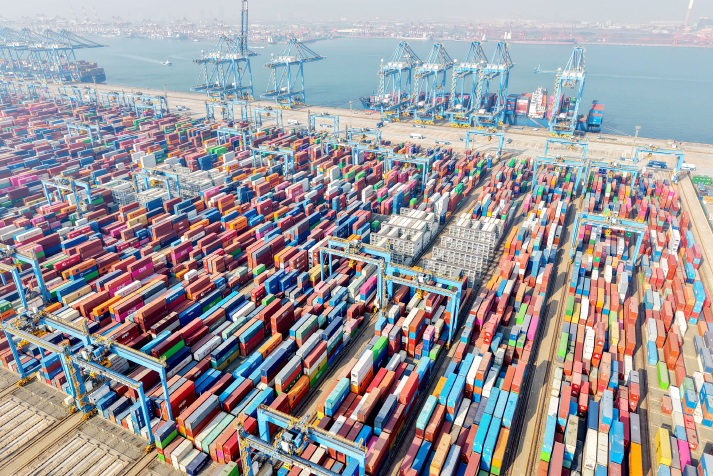| Voice |
| China's trade engine: Accelerating to new heights | |
|
|
 A tunnel boring machine rolls off the production line at an industrial park in Changsha, Hunan Province, on December 18, 2024. It will be exported to Zambia for mining tunnel construction (XINHUA)
Trade has, undoubtedly, become a political focal point over the past six years, ever since the first President Donald Trump administration initiated a trade war with wide-ranging tariffs on Chinese-made goods in 2018. In the post-pandemic years, some Western countries have pursued, rhetorically at least, a direction anchored by notions of "de-risking," "re-shoring" and "friend-shoring" as they spoke of a need to reconfigure global production systems and supply chains and reduce dependence on China. On the back of this, some academics, like Turkish economist Dani Rodrik, argued that the post-1990s era of "hyper-globalization" is over. Characterizing eras is an inherently difficult task. There are good reasons to doubt that the characterization necessarily tells us much about the changing contours of transnational economic value flows. The dynamics of trade and capital flows of the past 35 years are, in fact, not unprecedented. For instance, the internationalization of trade, capital flows and monetary systems was evident between 1870 and 1914. The international economy has been subject to bouts of structural change in the past century, suggesting that a lens that emphasizes "never-ending change" makes more sense. Over the past 35 years, we have witnessed the dramatic growth of the Chinese economy in terms of its productive capacity. In the past 25 years, it has played an increasingly important role in the networks of trade and investment flows. This transformation underpins the patterns that are being amplified today, but in no way should be treated as recent or sudden phenomena. Deeper integration In the years immediately following its accession to the World Trade Organization in 2001, China's principal trading relations were with the developed economies of the world. China emerged as the world's manufacturing hub, supplying high volumes of low-cost goods to the consumer markets of the developed world. Today, however, while China remains the only global manufacturing superpower, accounting for around 30 percent of manufacturing value added, its export markets have dramatically diversified. Right now, China's trading relations with the Global South are more important than those with the transatlantic markets and Japan. (The Global South consists of the nations of the world considered to have relatively low levels of economic and industrial development, typically located to the south of more industrialized nations—Ed.) In 2020, the Association of Southeast Asian Nations (ASEAN) surpassed the European Union as China's largest aggregate trading partner. More broadly, the key drivers of China's ongoing trade growth and surpluses continue to be the secular expansion of its economic relations with the Global South, especially participants of the Belt and Road Initiative (BRI). In 2024, China's trade volume with BRI partner countries reached more than 50 percent of its total trade for the first time in history. (The BRI is a China-proposed initiative that aims to boost connectivity along and beyond the ancient Silk Road routes—Ed.) In 2018, when Trump started the tariff war, exports to the U.S. comprised around 20 percent of China's total exports. This is no longer the case. The U.S. market today makes up about 15 percent of China's total exports. The U.S. is simply not as important a market as it once was. Advocates of "de-coupling" point to this sliding share as a sign of success. What they don't acknowledge is that trade value with the U.S. has actually grown. That the share of total exports has declined is a result of the fact that exports growth elsewhere has been faster. In 2018, China's trade surplus globally was about $350 billion. That figure is now almost $1 trillion, a three-fold increase in six years. The world isn't decoupling from China.  Containers stacked at a port in Qingdao, Shandong Province, on January 13 (XINHUA)
Salient features The trade wars have failed, as demonstrated by the changing contours of global trade. Here are some key points to illustrate this: First, China's ability to expand its overall trade is premised on its expanded productive capacity. China's model has been to not only move up the value curve, but to drive down unit costs. Intense domestic competition underscores the pursuit of productivity and efficiency, resulting in the availability of high-quality products at world-beating prices. Second, China's manufacturing output growth has in fact been largely absorbed by growing domestic demand. As of 2020, around 80 percent of Chinese manufacturing output was sold domestically, according to the Organization for Economic Cooperation and Development (OECD) Trade in Value Added (TiVA) database. In some sectors like electric vehicles, the domestic market has reached a share of around 90 percent. While China is a major trading nation, its economic drivers are principally anchored by the expanding domestic market. Third, China's aggregate trade balance is approximately 5 percent of its GDP. This is modest, illustrating the reality that the modern China model is not export-dependent. Fourth, Chinese enterprises are becoming capital exporters, establishing factories in different countries. This shift has, for example, altered trade patterns with the U.S., where reduced imports from China are offset by increased imports from Chinese firms operating outside of China. China's overall model drives down costs through productive efficiency and output abundance. Its own economy and those of the Global South benefit from this. By way of contrast, the Western model of financialized capitalism, a form of capitalism where financial markets, financial motives, financial actors and financial institutions play a dominant role in the operation of the economy, is built on confected scarcity underpinning a rentier economy, an economic system where income is derived primarily from the ownership of assets. The 2024 trade data demonstrate the effects of these differences. BR The author is an adjunct professor at Queensland University of Technology and a senior fellow at Taihe Institute. This article was first published on China.org.cn Copyedited by Elsbeth van Paridon Comments to yaobin@cicgamericas.com |
|
||||||||||||||||||||||||||||||
|